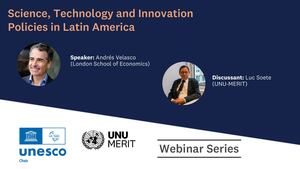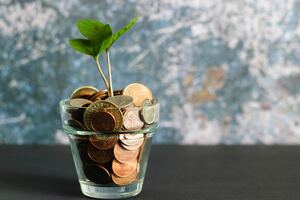UNU-MERIT UNESCO Chair event examines investment strategies for climate and development goals
When it comes to limiting global warming to 1.5 degrees Celsius, who will finance the investments needed to do so, and will the funding sources be domestic or foreign, public or private, or from debts or grants? And, in a macroeconomic context, how can we ensure that such investments will have their desired effects on the green transitions of nations?
These are the questions Andrés Velasco, Dean of the School of Public Policy at the London School of Economics, addressed in an online event entitled “Macroeconomics of the Green Transition in Emerging Nations,” the third instalment in a series of UNU-MERIT UNESCO Chair webinars on Science, Technology and Innovation Policies for Sustainable Development in Latin America. Velasco spoke alongside UNU-MERIT professorial fellow Luc Soete as well as, at times, Prof. Carlo Pietrobelli, professor of economics at the University Roma Tre, Italy, and head of the UNU-MERIT UNESCO Chair.
 Velasco, a former finance minister of Chile, focused mostly on the second of his two questions. He explained that even when the former is answered satisfactorily and countries have access to funding, the next challenge is to ensure that the funding will be invested effectively, in order to curtail emissions without creating undesirable trade-offs and consequences.
Velasco, a former finance minister of Chile, focused mostly on the second of his two questions. He explained that even when the former is answered satisfactorily and countries have access to funding, the next challenge is to ensure that the funding will be invested effectively, in order to curtail emissions without creating undesirable trade-offs and consequences.
A recent LSE/Brookings Institution study estimates that the world will need to invest $1.3 trillion by 2025 and $3.5 trillion by 2030 to generate higher levels of economic growth while still delivering on climate and development goals. This means that countries will need increased investment of around 2 percent of their GDP per year, possibly growing to 4 or 5 percent in countries where green infrastructure is currently insufficient.
Sourcing such financing – both public and private – needs a collective, international effort, given that all countries will benefit (or suffer, if the investment isn’t forthcoming), said Velasco. The case for rich nations helping to pay for the investment required by poor countries is watertight both economically and morally, he said, while acknowledging that even the best green investment plan will have undesirable side effects.
For low-income countries, a grant component is inevitable, but public debt is already significant, partly due to the impact of the COVID-19 pandemic. Other challenges, such as low tax revenue for low-income countries versus higher tax revenue for developed countries must also be factored in.
Macro gaps
These issues are well understood and some progress is slowly being made, but the same cannot be said for macroeconomic issues, two of which Velasco stressed are in need of further examination.
First, there’s the challenge of capital inflow and current account deficit. A larger capital account surplus means a larger current account deficit, and whilst this is generally manageable as long as financing is stable, when private capital flows are less stable than public capital flows, this can spell disaster, particularly if there is a ‘sudden stop’ to investment, as history has shown.
These current account reversals can have devastating economic and political consequences – as with the Asian financial crash of the late 1990s where, for example, the current account reversal of Malaysia was 20 percent of GDP. Debt, banking, growth and unemployment crises are the inevitable, traumatic outcomes.
Today, Latin America sees similar occurrences – although not as large – due to the pandemic. Most finance ministers are therefore eager to put a ceiling on investments of all kinds and to make capital flows more reliable.
The second problem is associated with real exchange rate appreciation, which arises from a sudden, sharp increase in exchange rate growth. This can lead to, among other outcomes, a reduction in green investment. Goods produced at home become more expensive relative to those purchased from overseas, as Velasco illustrated with fictitious examples in low- and middle-income countries.
Location, location, location
Soete applied Velasco’s examples to Europe, focusing on the geographical and climate differences across countries and the impact this has on energy sources and supply as well as on cost differences of production and delivery. Generally, green sources of energy are distributed unevenly, which will have major implications not only on transportation costs but also increasingly on the movement of people. Landlocked areas on the continent have very different needs as compared to seaside areas in the UK, Belgium and the Netherlands, for example.
This is leading to discussions in European countries, such as in Germany, where investment in massive electricity grids is designed to bring wind energy from the north to the south and to heavy industry areas. Intervention could incentivise industry to relocate to be closer to renewable energy sources to reduce transport costs, said Soete, such as industry in the south of Germany moving up toward the wind farms in the North Sea or the Baltic Sea.
While green infrastructure is indispensable, concluded Velasco, the world will not achieve emissions reduction goals without acknowledging and addressing the challenges around them.
Recording of the webinar
To learn more about this topic, watch and listen to the recorded version of this session on UNU-MERIT’s YouTube channel:
ANY COMMENTS?
NOTA BENE
The opinions expressed here are the participants’ own; they do not necessarily reflect the views of UNU.
MEDIA CREDITS
Photo by Micheile Henderson on Unsplash




